While the Air-King refers to the historical links between Rolex and aviation, this new model makes a modern statement with a 40-mm case, boldly styled dial, and Rolex’s own “Superlative Chronometer” certification.
Take the silhouette of the Milgauss, add a touch of the Explorer, a golden crown-shaped logo on the dial, a few dashes of Rolex green, and the model’s name printed in italics across its face and presto! That’s how the new Air-King appeared, in all its sleek and alluring glory, at its premiere in 2016. Its exterior shows none of the grand history and interesting anecdotes that accompany this watch and make it one of Rolex’s most popular models. Newcomers to the brand frequently choose this watch as their very first Rolex – not only because of its comparatively low price.
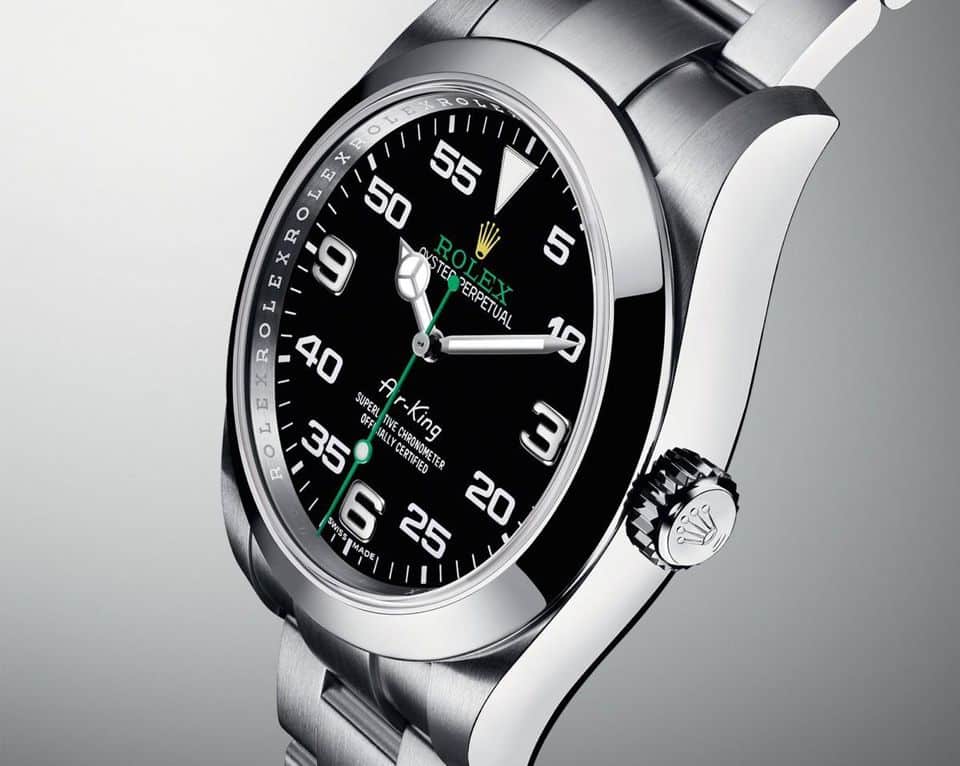
Rolex’s historical literature recalls the pioneering English airman Charles Douglas Barnard who took part in record-breaking flights and air races in the 1920s and ’30s, during the golden age of aviation. Because of the Oyster’s unusual qualities, Barnard hailed it as superbly suited for pilots – and he promised to wear it on all of his future long-haul flights.
Another piece of history involves the pilots in Britain’s Royal Air Force: These flyers were so enthusiastic about their watertight Oyster timepieces that they chose to leave their officially issued watches on the ground and spend their own money to buy Rolex watches to wear in-flight. When Rolex founder Hans Wilsdorf heard about this, he dedicated a line of watches exclusively to the British pilots. The italicized lettering used for the name “Air-King” was specially created for the dials of this series in the 1950s.
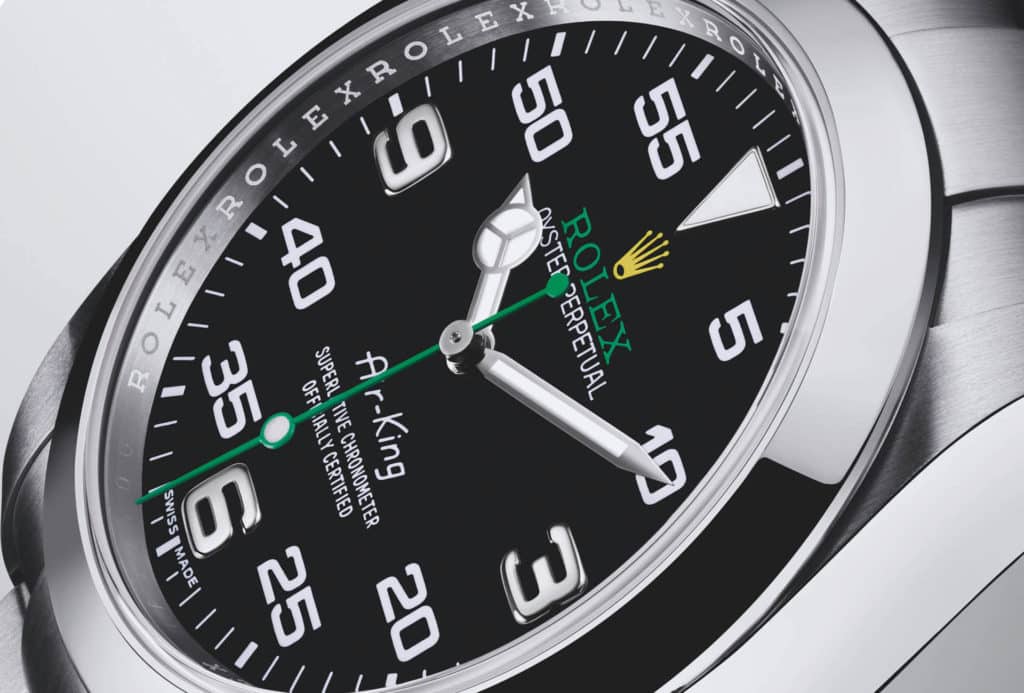
While the Air-King has appeared in many variations over the years, collectors are especially keen to own the versions that are associated with unique anecdotes. For example, Pan American Airways gave Air-King models to its veteran pilots as retirement gifts, and now these watches are avidly sought on the collectors’ market.
The Air-King Date with date display, which was produced in the 1950s and ’60s, is also a rare, unusual and eagerly coveted item. Although it was originally made for pilots, the Air-King steadily gained popularity outside the cockpit, giving Rolex good reason to re-release it. Originally 34 mm in diameter, Rolex’s modern version has a 40-mm stainless-steel case.
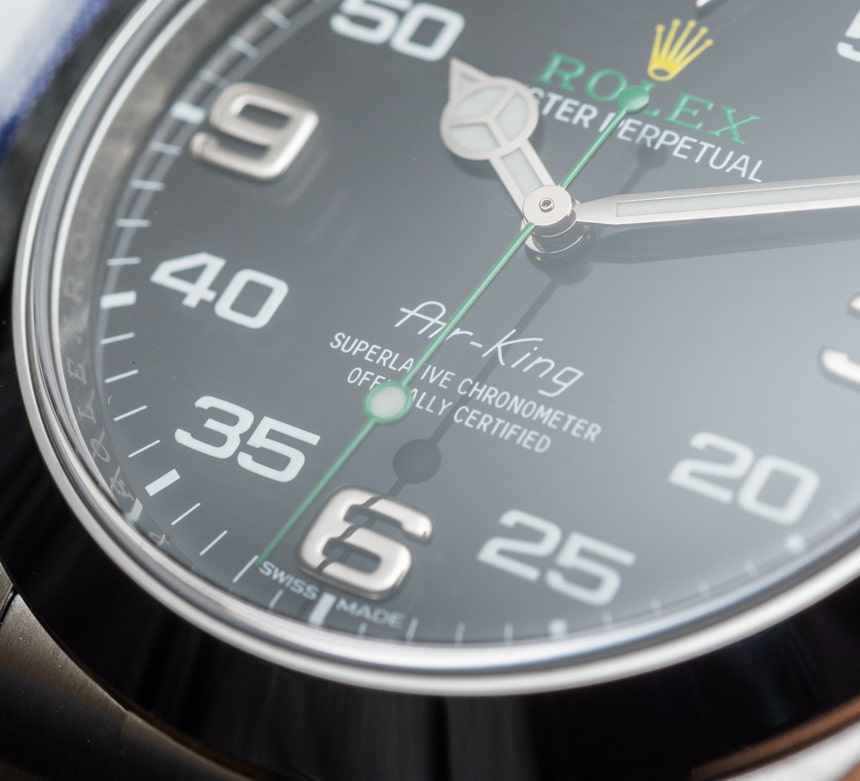
Rolex fans are familiar with the case’s styling from the Milgauss. The distinctive middle piece is formed from a solid block of 904L stainless steel, which is highly resistant to corrosion. And the massive, three-row, Oyster bracelet is made from the same steel alloy. A smooth, polished bezel tops the case and surrounds the sapphire crystal. The case is securely sealed using a simple, fluted, screwed back that cannot be opened without a special tool. The Oyster case, which shares its name with the similarly watertight mollusk, resists water pressure to a depth of 100 meters.
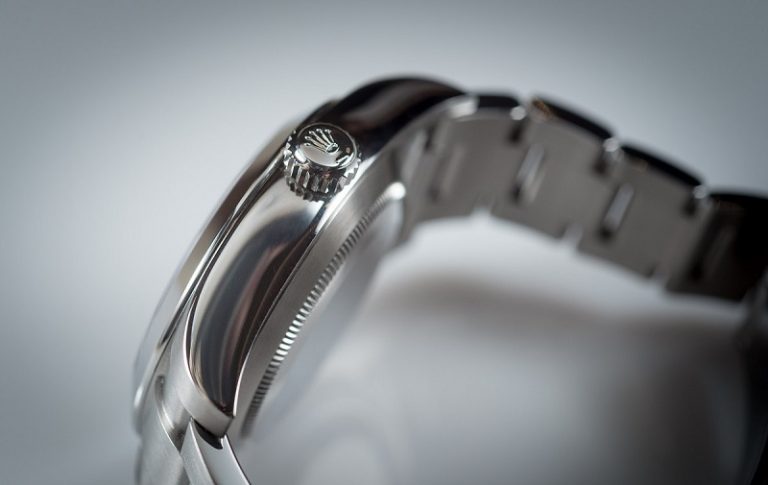
The hermetic seal also relies on a patented, double insulation system for the Twinlock crown. Rolex makes this special insulation visible on the winding crown. The code depends on the case material: If the watch has a stainless-steel case, as does our test model, then there’s a stroke underneath Rolex’s eye-catching, embossed logo; if the case is made of gold, two dots are stamped there; and if the watch has a platinum case, only a single dot is used. The Air-King is also equipped with a soft-iron inner case that enhances the movement’s resistance to magnetic fields.
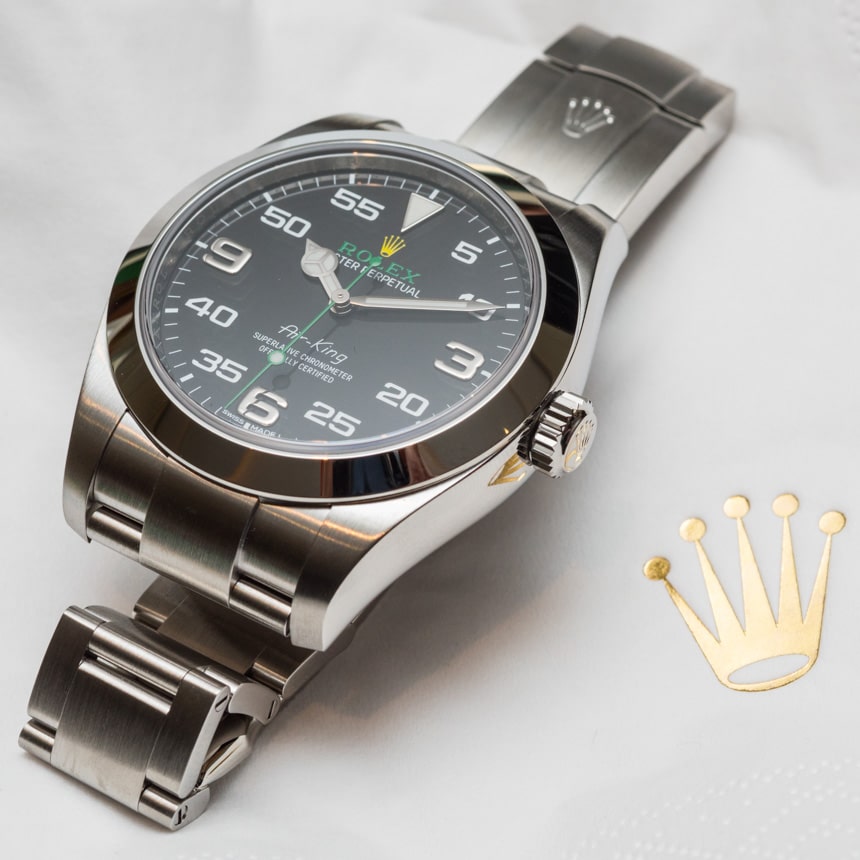
The same inner case protects the Milgauss, which is so named because it remains unaffected by magnetic fields up to one million millgauss, i.e., 1,000 gauss or 80,000 A/m. The Air-King has the same degree of protection.
Especially strong resistance to magnetic fields is also achieved through innovations in Caliber 3131, which was encased inside the Milgauss before it found its way into the Air-King. This caliber is equipped with a hairspring made from Rolex’s patented blue Parachrom. This alloy, which consists of niobium and zirconium in combination with oxygen, isn’t only resistant to magnetic fields, but also remains very stable when it encounters temperature fluctuations and mechanical shocks.
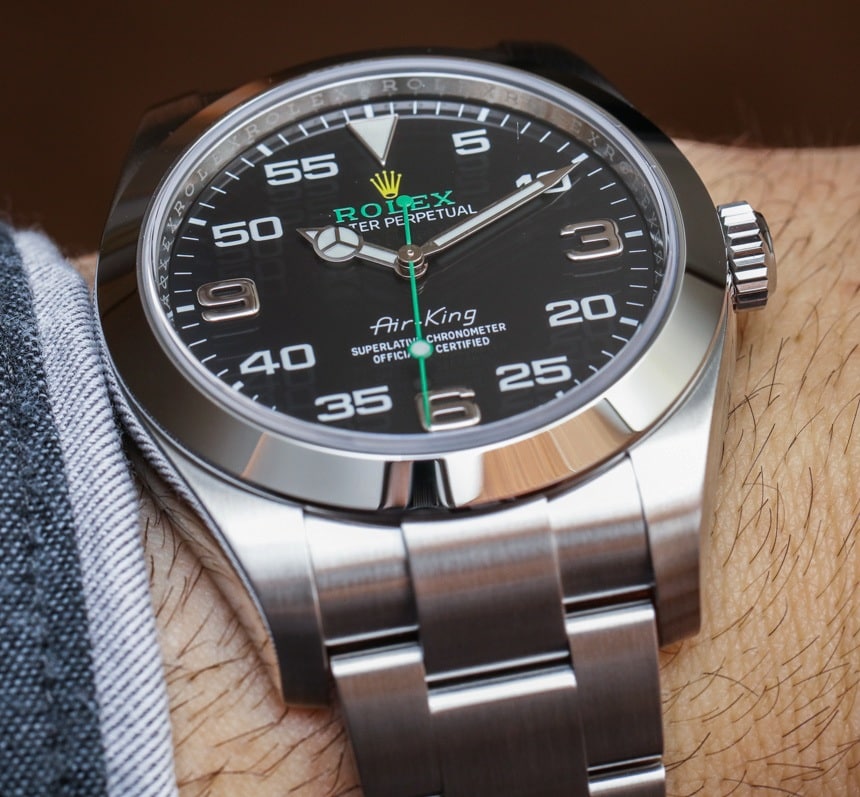
The presence of the blue Parachrom hairspring, which ends in Rolex’s special terminal curvature, often leads aficionados to overlook the fact that the balance also plays an important role in the precision of the rate. The balance that Rolex developed is made of Glucydur, a copper-beryllium alloy with paramagnetic properties and a low coefficient of thermal expansion.
Four Microstella nuts can be turned to finely adjust the balance. Compared to a conventional screw balance, this system also allows the oscillator to undergo fine tuning after it has been installed in the movement. Thanks to their star shape, these tiny nuts can be grasped and adjusted in every position.
Automatic Caliber 3131 is a modernized version of Caliber 3130, which, in turn, traces its ancestry to Caliber 3135. Along with the blue Parachrom hairspring, its roster of equipment also includes an escapement with a paramagnetic escape wheel. An ultraviolet LIGA method is used to fabricate this component from a nickel-phosphor alloy.
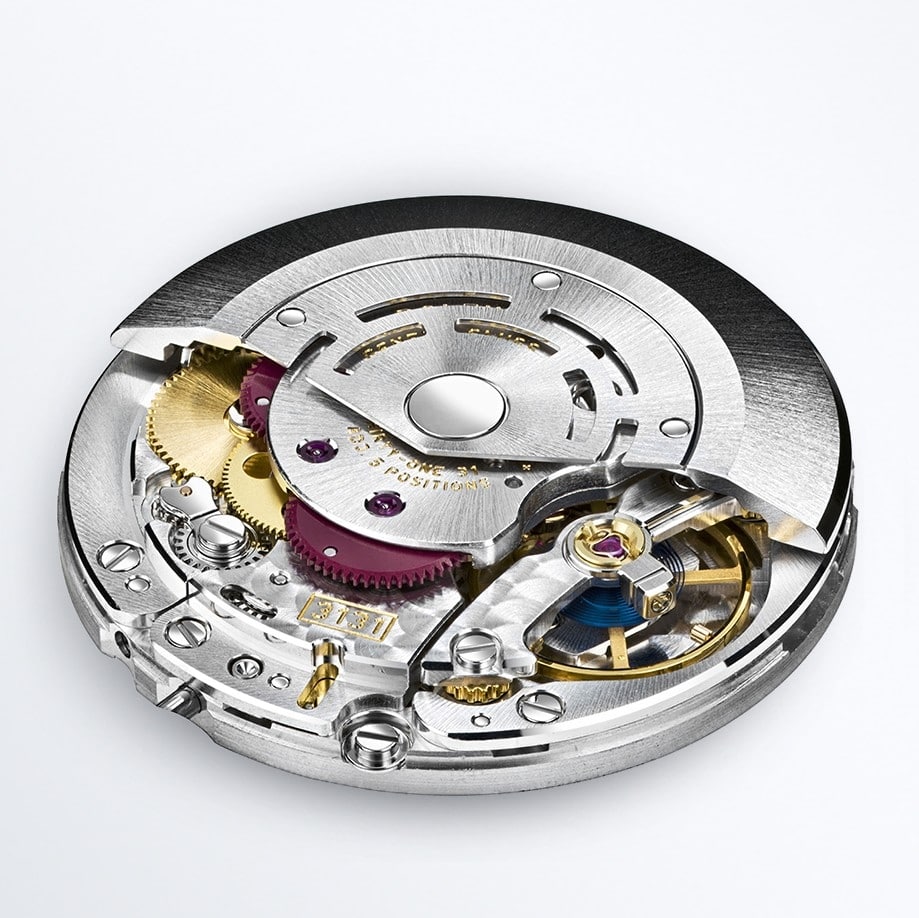
In 2015, Rolex redefined the standards of precision for its “Superlative Chronometers,” a distinction that was also earned by our test watch with Caliber 3131 after it passed rigorous test conducted according to Rolex’s own criteria in laboratories on the brand’s premises. Unlike COSC testing, Rolex examines finished and completely assembled watches, which are required to perform above the standards that would earn them the official Swiss chronometer certification.
After its caliber has been encased, the rate of a watch that will ultimately qualify as a Superlative Chronometer must not deviate from perfect timekeeping by more than approximately 2 seconds per day. Our timing machine confirmed just how ambitious these goals truly are. Although our particular specimen of the Air-King didn’t remain entirely within the narrow range stipulated by Rolex, it nonetheless kept time with well-balanced, chronometer-worthy accuracy in every position. Our test watch performed within the permitted tolerance of 2 seconds on the wrist.
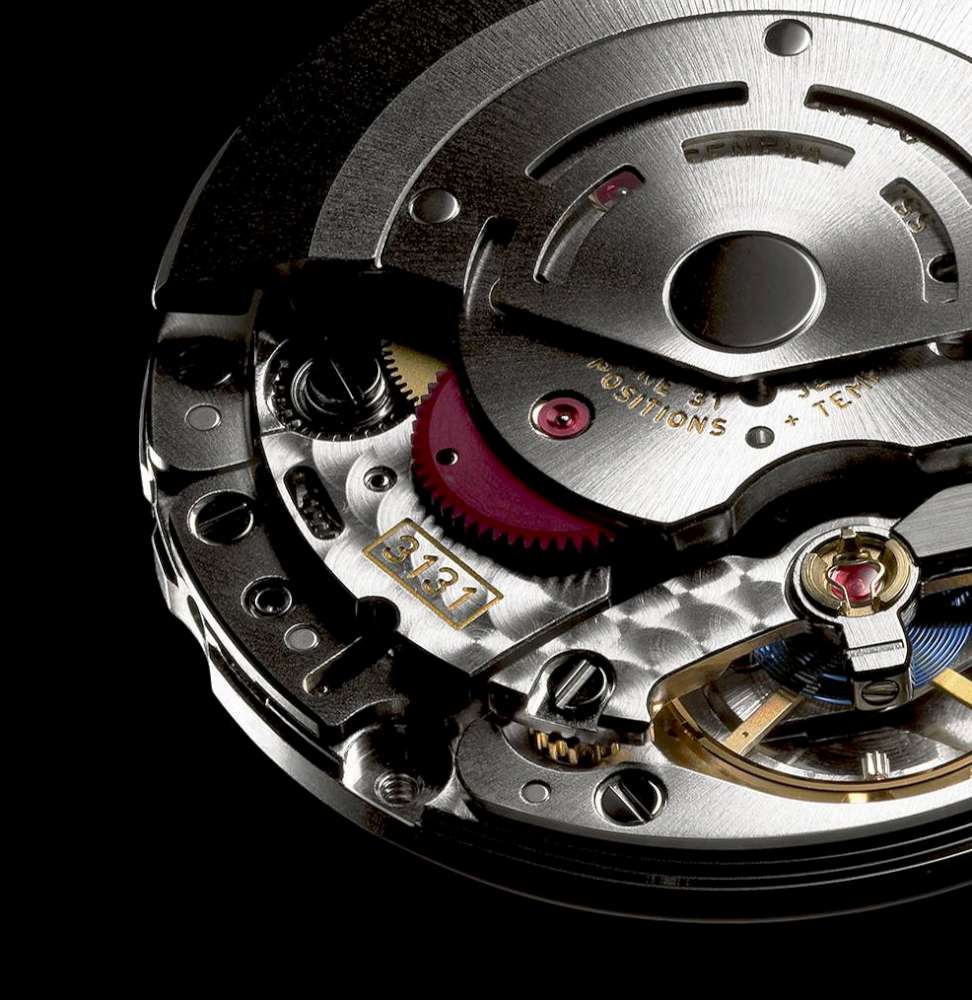
This empirical performance isn’t only significant for us, but also extremely important to Rolex, which guarantees that the watch will uphold, in daily wear on the wrist, the strict standards expected of a Superlative Chronometer. The brand’s international warranty is valid for a period of five years. Unfortunately, we weren’t able to keep our borrowed Air-King quite that long.
Unlike Caliber 3135, Caliber 3131 has no date mechanism and therefore supports no date display. Some connoisseurs might lament its absence on the watch’s dial. And while we’re speaking of its face, the Air-King’s dial forms a stylistic bridge to Rolex’s aviation tradition. With its bold contrasts, luminous elements and characteristic triangle at 12 o’clock, the Air-King’s dial references the design of classical pilots’ watches.
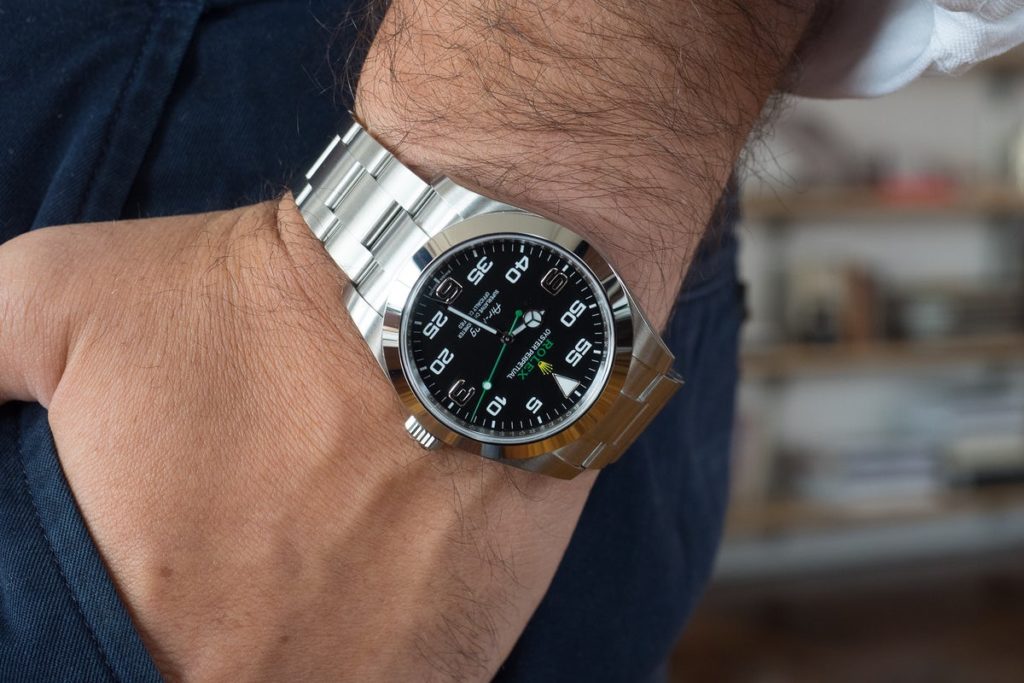
The thoroughgoing minutes circle is marked with Arabic numerals at 5-minute increments. This scale, however, is interrupted by applied hour numerals made of white gold at the 3, 6 and 9 o’clock positions. These three numbers are found on the dials of some historical models and are also present on the contemporary Explorer where they collaborate with bold hour indexes.
The Air-King’s trio of hands is adapted from sporty Rolex models, e.g., the Explorer, the GMT-Master or the Submariner, but isn’t found on historical Air-King models. Chromalight fillings glow in the dark with a handsome light blue shine. The orientation triangle at 12 o’clock gleams in this same hue on the otherwise matte black dial.
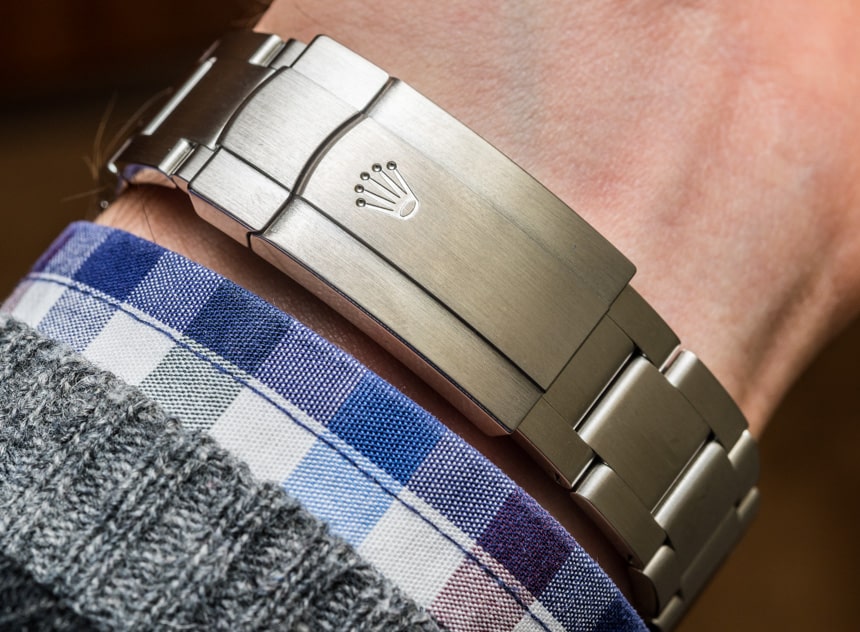
Only by referring to the gleaming triangle can the watch’s wearer read the time in the dark. In daylight, the bright yellow crown-shaped logo, along with the green accents provided by the seconds hand and the brand’s name, add unique features that complement the distinctive lettering spelling out the “Air-King” name.
Connoisseurs will recall seeing the Oyster bracelet with its folding Oysterclasp on other Rolex models. “Oysterclasp” means that the upper part of the closure is divided, and this division makes it look very much like a safety bow. The locking hook is released from the lower part of the clasp when the smaller, front part is lifted.
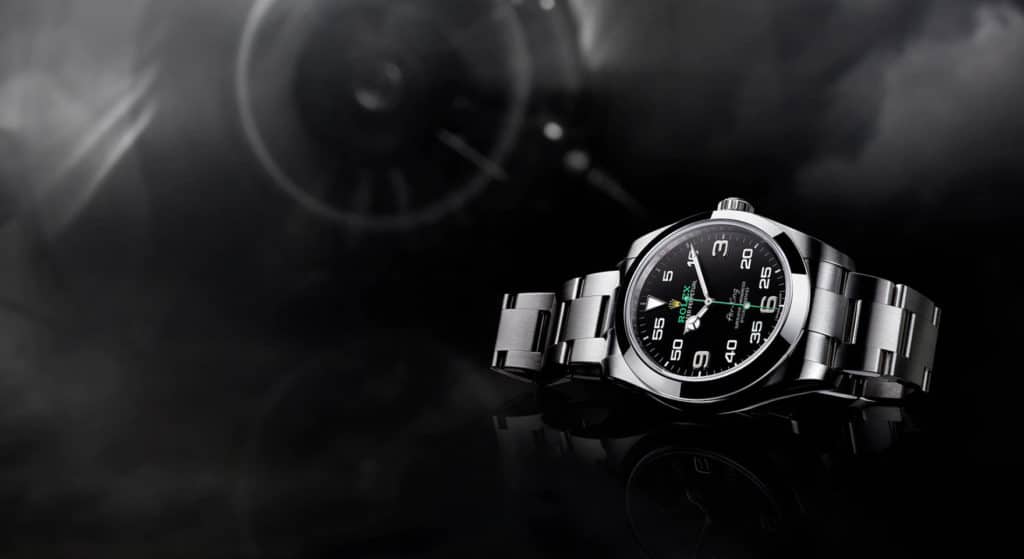
The short lever makes opening the clasp very easy and secure. The other end of the upper part of the clasp hosts the Easylink extension, which can be folded out to add 5 mm to the bracelet’s length. In its lengthened state, the hinged mechanism is cleverly hidden inside the folding clasp. All elements are satin finished and are polished only along their sides, which nicely matches the look of the polished sides of the case.
Embodying a harmonious synthesis of stylistic elements associated with Rolex and encasing a modern, state-of-the-art movement, the new Air-King does much more than merely evoke echoes of the past. Just the opposite: Priced at $6,200, this model may not be a bargain, but it does serve as a relatively affordable entrée into the Rolex world. And it’s also an attractive option to compare with some of the models available from other watch brands.






